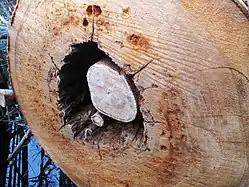Strangler fig is the common name for a number of tropical and subtropical plant species in the genus Ficus, including those that are commonly known as banyans. Some of the more well-known species are:
- Ficus altissima
- Ficus aurea, also known as the Florida strangler fig
- Ficus benghalensis
- Ficus benjamina
- Ficus burtt-davyi
- Ficus citrifolia
- Ficus craterostoma
- Ficus tinctoria
- Ficus macrophylla
- Ficus obliqua
- Ficus virens
- Ficus watkinsiana
- Ficus henneana
These all share a common "strangling" growth habit that is found in many tropical forest species, particularly of the genus Ficus.[1] This growth habit is an adaptation for growing in dark forests where the competition for light is intense. Strangler figs suck up the nutrients from its victims,[2] causing them to die eventually. These plants are hemiepiphytes, spending the first part of their life without rooting into the ground. Their seeds, often bird-dispersed, germinate in crevices atop other trees. These seedlings grow their roots downward and envelop the host tree while also growing upward to reach into the sunlight zone above the canopy.[3][4]
An original support tree can sometimes die, so that the strangler fig becomes a "columnar tree" with a hollow central core.[5] However, it is also believed that the strangler fig can help its support tree survive storms.[6]
Strangler trees are able to colonize the challenging habitat found on the sides of buildings in urban areas. Strangler figs in the tropics are pre-adapted to adopt an aerophytic as well as "acrobatic" urban life by clinging on to building envelopes.[7]
Gallery
 A strangler fig sapling starts to grow on a tree. Roots can be seen
A strangler fig sapling starts to grow on a tree. Roots can be seen The trunk of a bald cypress, surrounded by the roots of a strangler fig
The trunk of a bald cypress, surrounded by the roots of a strangler fig A strangler fig. The supporting tree, now dead, can also be seen. Photo from Kannavam forest
A strangler fig. The supporting tree, now dead, can also be seen. Photo from Kannavam forest
 Old strangler fig in the final stage, Costa-Rica, Pacific
Old strangler fig in the final stage, Costa-Rica, Pacific A cross section of a bald cypress at the Corkscrew Swamp Sanctuary, showing the roots of a strangler fig inside of it
A cross section of a bald cypress at the Corkscrew Swamp Sanctuary, showing the roots of a strangler fig inside of it A columnar tree formed by a strangler fig after the central tree has died. The tree is hollow as seen in this photograph from below.
A columnar tree formed by a strangler fig after the central tree has died. The tree is hollow as seen in this photograph from below.
See also
- Ficus benjamina - weeping fig, benjamin fig or ficus tree
References
- ↑ Zhekun, Zhou & Michael G. Gilbert (2003) "Flora of China" (Moraceae) 5: 21–73. hua.huh.harvard.edu Archived 2006-09-01 at the Wayback Machine
- ↑ "The Strangler Fig Tree: A Tree That Lives For Many Years". SC Garden Guru. Retrieved 29 December 2022.
- ↑ Serventy, V. (1984). Australian Native Plants. Victoria: Reed Books.
- ↑ "Light in the rainforest" 1992 Tropical topics. Vol 1 No. 5, epa.qld.gov.au Archived 2007-07-01 at the Wayback Machine
- ↑ Margaret Lowman; H. Bruce Rinker (2004). Forest Canopies. Academic Press. pp. 180–. ISBN 978-0-12-457553-0.
- ↑ Richard, Leora.; Halkin, Sylvia (June 2017). "Strangler figs may support their host trees during severe storms". Symbiosis. 72 (2): 153–157. doi:10.1007/s13199-017-0484-5. S2CID 29202538.
- ↑ Jim, C.Y. (2018). "Epiphytic strangler trees colonizing extreme habitats of building envelopes in Hong Kong". Landscape and Urban Planning. 178: 281–291. doi:10.1016/j.landurbplan.2018.07.003. S2CID 92651962.
External links
- The Tropical Rain Forest, including photos of strangler figs
- The Queen of Trees: Fig Trees – From the Sacred to the Strangler
- Being strangled may save this tree’s life
